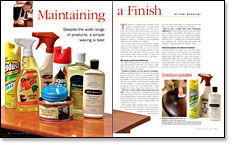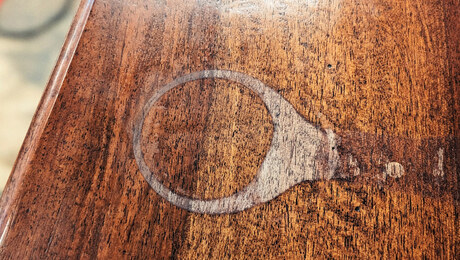Maintaining a Finish
Despite a wide range of products, a simple waxing is best
Synopsis: There are thousands of furniture care products on the market, from wood cleaners, to dusting sprays, to oils, to waxes. And perhaps more than other group, woodworkers can be vulnerable to the advertising hype that says these products are what you need to keep your beautiful furniture looking beautiful. Finishing expert Teri Masaschi cuts through all the hype—for that’s just what it is—and tells you exactly what products will maintain the finish you worked so hard to achieve. The answer is simple: Keep it simple.
The number of furniture-care products on the market is staggering: There are liquid waxes and polishes, spray polishes, oils with color in them, dust removers with scents in them, and dozens of paste waxes. Everyone has seen, read, or heard the advertisements for these products: The wood in your house must be fed; it is drying out, and it must be rehydrated or oiled! Or, conversely, too much polishing will lead to the dreaded “wax buildup.”
Most of this is pure hype, but the products sell because most homeowners want to keep their furniture looking its best. Woodworkers are even more motivated to take care of their creations and thus are extra vulnerable to the sales pitch. The good news is that you can ignore most of these products; I’ll show you which ones have value and how best to use them.
Why sprays and oils have limited use
The biggest-selling furniture-care products are aerosol sprays and liquids because they are so easy to apply. They fall into three main categories: emulsion polishes, oils, and silicone polishes.
Emulsion polishes are best kept for cleaning—These are emulsified blends of water and oil packaged in cans and sprays. They are recognizable by their milky appearance when first applied. Because emulsion polishes contain both water and petroleum distillates, they are good for removing grease and dirt. They are also suitable for a quick dust pickup and leave a non-greasy surface, but a very limited shine. A cloth dampened in warm, soapy water cleans just as well.
Oils leave a slick surface that attracts dust and dirt—There is a large range of furniture oils, but the main ingredients usually are petroleum-based mineral oil and mineral spirits. Sometimes the latter is replaced with or augmented by a citrus-based solvent that gives a pleasant smell. Other options include added color to help hide scratches.
When applied, these products leave a very temporary shiny, slick surface. They are a favorite of antiques dealers because that glorious shine will last long enough to get the piece out of the shop.
From Fine Woodworking #183
For the full article, download the PDF below:
Fine Woodworking Recommended Products

Osmo Polyx-Oil


Odie's Oil






















Log in or create an account to post a comment.
Sign up Log in